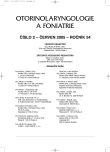Experience in Vestibular Habituation Training in the Therapy of Balance Disorders
Zkušenosti s vestibulárním habituačním tréninkem při léčbě poruch rovnováhy
Souhrn:
Cílem práce je prezentovat zkušenosti s vestibulárním habituačním tréninkem při léčbě poruch rovnováhy na ORL oddělení FN Na Bulovce.
Vestibulární habitauční trénink využívá adaptace, habituace a kompenzace vestibulárního aparátu. Naše prospektivní studie probíhala od února 2002 do srpna 2004, bylo vyšetřeno celkem 132 pacientů s poruchou rovnováhy ve věkovém rozmezí 19–85 let s průměrným věkem 52,3 let. Největší skupinu, 56 %, tvořili pacienti s periferním typem poruchy, centrální typ byl zastoupen u 38 % pacientů a smíšená porucha u 6 % pacientů. Pacienti byli rozděleni do dvou skupin, v jedné probíhala pouze farmakoterapie, v druhé kombinace farmakoterapie a vestibulárního habituačního tréninku. Pacienti byli komplexně vyšetřováni, aby se stanovil vývoj onemocnění.
Hodnocení bylo subjektivní i objektivní. Výsledky potvrdily pozitivní vliv vestibulárního habituačního tréninku na poruchy rovnováhy, především u periferních poruch rovnováhy.
Klíčová slova:
vertigo, vestibulární habituační trénink, farmakoterapie.
Authors:
L. Ferencová; J. Stoilová
Authors‘ workplace:
Oddělení otorinolaryngologie FN Na Bulovce, Praha
primář MUDr. J. Veselý
Published in:
Otorinolaryngol Foniatr, 54, 2005, No. 2, pp. 102-104.
Category:
Original Article
Overview
Summary:
The aim of the work was to present the experience in vestibular habituation training with the therapy of balance disorders at our Department of Otorhinolaryngology in the Teaching Hospital Na Bulovce in Prague.
Vestibular habituation training makes use of adaptation, habituation and compensation of vestibular appliance. 132 patients with balance disorders at the age of 19 to 85 years, the means age being 52.3 years have been explored in the period from February 2002 till August 2004. The largest group, 56% of patients, included patients with peripheral type of vestibular disorder, the group of central type of vestibular disorder included 38% of patients and the group of mixed type included 6% of patients. Patients were divided into two groups. The first one included patients only with pharmacotherapy, the second one included patients with the combination of pharmakotherapy and vestibular habituation training. Patients were comprehensively explored to define the progress of disorder. The evaluation of progress was both subjective and objective. The results proved true positive effect of vestibular habituation training to balance disorders, especially to peripheral type of balance disorders.
Key words:
vertigo, vestibular habituation training, pharmacotherapy.
Labels
Audiology Paediatric ENT ENT (Otorhinolaryngology)Article was published in
Otorhinolaryngology and Phoniatrics

2005 Issue 2
Most read in this issue
- Surgical Treatment of Lower Concha Hypertrophy by Means of Microdebrider
- Reflex Response of the Stapes Muscle Induced by Acoustic Stimulation: Systematic Arrangement of Conditions for the Induction
- Short-term and Long-term Functional Results of Stapedoplasty
- Experience in Vestibular Habituation Training in the Therapy of Balance Disorders
